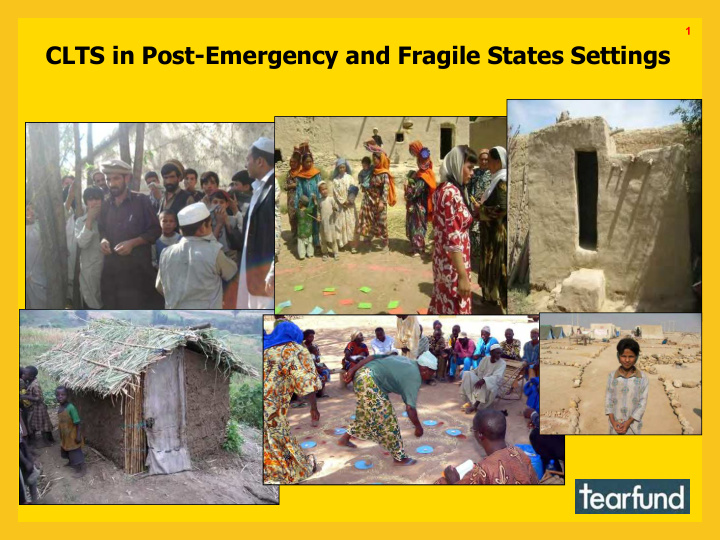



1 CLTS in Post-Emergency and Fragile States Settings
2 Aim of this webinar: To relate key learning points around CLTS in post emergency and FCAS contexts, and to stimulate further discussion and learning amongst CLTS implementing agencies and practitioners Exploring: “How, when, and in what circumstances can a CLTS-style process of analysis, action and collective behaviour change be undertaken?” Learning points relate to one of three situation typologies: 1. Displaced people living in camps 2. Displaced people living in host communities; 3. People living in settled villages in conflict- affected areas, or undergoing recovery / rehabilitation
3 Displaced people living in camps Oxfam GB in Hyderabad IDP camps, Pakistan Sonya Sagan, 2010 • Prioritise CLTS/CATS in sites where sanitation already exists: CLTS found to be most effective in keeping environment clean rather than for building new toilets (Sagan,S., Polo,F.) • Emphasis on quality facilitation: very well facilitated triggering activities, along with consistent follow-up of the communal action plan, directly addressed the issue of poor use of existing latrines
4 Displaced people living in camps CATS Pilot in Haiti , Fiorella Polo, Unicef, 2010 • CATS works well where improved sanitation already exists: it spurs people on to take ownership of cleaning and maintenance, and to proper latrine use • To reduce likelihood of latrines being dismantled, ensure adequacy of family shelters • Success of triggering is more dependent on quality of facilitation than even the physical criteria • Avoid facilitating CATS/CLTS alongside several supply-driven projects.
5 Displaced people living in host communities Community approach to Total Sanitation, Sudan , Eltayib et al , WES, 2010 • CLTS applied in a “Total Sanitation” context, incorporating water handling and use, home- based water treatment, food hygiene, and clean environment, besides safe excreta disposal • Embed the CATS/CLTS process in a wider programme of self-improved (non-subsidised) WASH facilities, so reducing expectancy for hardware donations • Support livelihoods initiatives (e.g. capacity building of local artisans and service providers) • Strong use of local religious leaders (Moslem context) to disseminate messages of personal cleanliness and well-being.
6 People living in settled villages in conflict-affected areas, or undergoing recovery / rehabilitation Tearfund, Afghanistan, Murray Burt, 2011) Key principle was promotion of livelihood opportunities: Construction of latrines was left to homeowners and local masons Tearfund provided training to local tradesmen, including environmental considerations, latrine siting, design and construction quality.
7 Livelihoods Opportunities • Increased demand for hand washing facilities met by local steel workers, producing small steel drums with a tap designed for hand washing. • Increased demand for soap met by local shop owners.
8 People living in settled villages in conflict-affected areas, or undergoing recovery / rehabilitation Tearfund, Afghanistan (Murray Burt, 2011) • Similar to WES in Sudan, embed the CLTS process in a wider programme of improved WASH access, based on a demand-led, livelihoods approach • Make us of local religious leaders, and the influence and opportunities they have in bringing messages of personal cleanliness and well-being to their community. Involve religious leaders in advocating to government authorities for replication of the process, and subsequent policy change • Post- triggering, and once latrine construction in progress, “PHAST” used to consolidate hand-washing practice.
9 People living in settled villages in conflict-affected areas, or undergoing recovery / rehabilitation Fragile & insecure contexts: experience from Somalia and South Sudan (Balfour, N., Otieneo, P., Mutai, A., Thomas, A., UNICEF, 2104) South Sudan • A phased scale-up can be more successful than rapidly going to scale. Launch in areas that are accessible, with a plan for expansion to more difficult areas once the approach is well established (South Sudan) • Partnership with local NGOs was an essential component in Somalia. Their facilitation skills and mobility enabled follow- up and support to natural leaders where access for INGOs, UN and government was limited. Implementation alongside Somalia CHWs, who already had high respect/acceptance in the communities (Somalia) • Institutional triggering is critically important in fragile contexts. Involvement of key opinion leaders, particularly traditional and religious leaders, is critical during triggering and implementation. (South Sudan) .
10 People living in settled villages in conflict-affected areas, or undergoing recovery / rehabilitation The rationale for a “kick-start ODF” programme, Nepal (Wambua, E., Tearfund, 2015) • Close working with National and District Government from the outset, recognising that they already supported a no-subsidy total sanitation approach • Give focus to strong collaboration and joint advocacy by WASH agencies holding the same vision for rehabilitation • Subsidy toward sanitation may be appropriate in a context where high HH ownership and usage of latrines existed prior to a natural disaster. In this case, there may be no need (or mandate) to re- trigger. Focus on achieving more resilient shelter + sanitation facilities by “building back better”
11 On-going Challenges Subsidies: • Suggestion that we are subtly moving towards smart, targeted subsidies (e.g. vouchers, rebates, and integrating financing strategies into programming); • How to deal with concurring supply-driven projects, which can undermine the behaviour change-based processes. And how to influence donors of aid response! Capacity and land issues: • Where land-tenure is uncertain, or where land owners will tolerate only temporary sanitation facilities, affected populations will be reticent to invest effort or money into building improved sanitation.
12 The future – further work, further evidence Cash Programming: Good linkage to sanitation-ladder principle, but at the same time it can undermine self-actuation by mimicking hardware subsidy. Payment by Results: Negative side: focus on payment qualifying outputs Positive side: greater efforts placed on defining & achieving sustainable outcomes Multi-Sectoral approaches: Appropriate when many needs must be met, and in face of climate change (effect on water supplies, food insecurity), conflict. But, will sanitation still remain the “poor cousin” evident in past WASH policy & programming?
Thanks for listening Questions? Comments? Contributions?
Recommend
More recommend